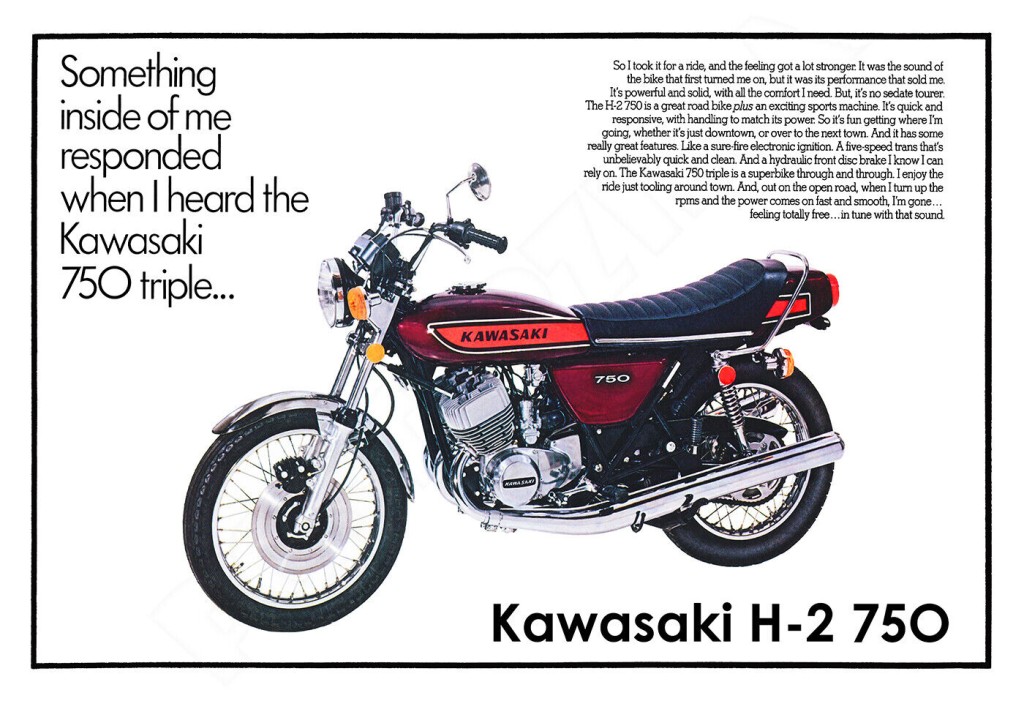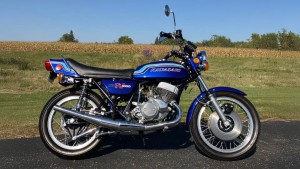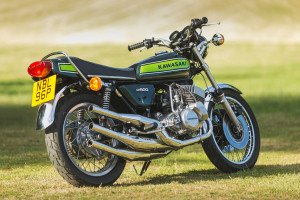 120-bhp 1000cc 4-cylinder Widowmaker from Allen Millyard…
120-bhp 1000cc 4-cylinder Widowmaker from Allen Millyard…
Introduced in late 1971, the Kawasaki H2 Mach IV 750 was the fastest-accelerating, scariest production machine money could buy. The 748cc air-cooled two-stroke triple-cylinder engine made 74 brake horsepower in factory trim, and drag racer Tony Nicosia set a new AHRA quarter-mile record of 11.95 seconds on an unmodified H2 750 (Serial #00012) at the Spring Nationals in Fremont. For less than $1400, you could sweep the streets clean of most of the big-block muscle cars prowling your local drive-in or dragstrip.

 Of course, the H2 didn’t arrive out of a vacuum. It grew on the success of the 500cc H1 Mach III — a bit of monster in its own right. However, the motorcycle arms race was in full swing, and no manufacturer could afford to sit on their laurels:
Of course, the H2 didn’t arrive out of a vacuum. It grew on the success of the 500cc H1 Mach III — a bit of monster in its own right. However, the motorcycle arms race was in full swing, and no manufacturer could afford to sit on their laurels:
“Kawasaki’s ambitions that spawned the H1 were hardly quenched by its success, particularly since the motorcycle industry was also growing at a rapid pace. In addition, the arrival of a certain Japanese competitor’s groundbreaking four-cylinder 750 bike in 1969 had admittedly set a benchmark of its own. So what to do? Take the H1 and amplify it. This was war.” –Sport Rider

 Though the H2 750 was called a superbike, the term was still in its infancy. Things like handling, chassis rigidity, and braking performance were given only a fraction of the same attention as horsepower and outright acceleration. Soon the wheelie-happy, wobble-prone H2 was hailed as a “Widowmaker” — and the moniker stuck.
Though the H2 750 was called a superbike, the term was still in its infancy. Things like handling, chassis rigidity, and braking performance were given only a fraction of the same attention as horsepower and outright acceleration. Soon the wheelie-happy, wobble-prone H2 was hailed as a “Widowmaker” — and the moniker stuck.
“Evil, Wicked, Mean And Nasty” –Cycle World, 1975

 Of course, it’s that very infamy that continues to make the H2 750 so alluring. And if three 249cc cylinders is scary, what about…four?
Of course, it’s that very infamy that continues to make the H2 750 so alluring. And if three 249cc cylinders is scary, what about…four?

 None other than the living legend Allen Millyard stepped in to answer the question no one was crazy enough to ask. Millyard — a retired nuclear engineer who works out of his single garage in the English countryside — is best-known for machines like his 5000cc V-twin “Flying Millyard” and V10-powered “Millyard Viper.”
None other than the living legend Allen Millyard stepped in to answer the question no one was crazy enough to ask. Millyard — a retired nuclear engineer who works out of his single garage in the English countryside — is best-known for machines like his 5000cc V-twin “Flying Millyard” and V10-powered “Millyard Viper.”
However, the majority of his builds are much subtler at first glance.
I’ve always tried to make my bikes look ‘factory’ as if they’ve been made by the original manufacturer – even though this often means a lot of extra work.” -Allen Millyard, MCN

 That’s certainly the case with this 1000cc four-cylinder H2, which looks like it might have rolled right off the Kawasaki production line. In fact, if you were simply perusing the listings for the upcoming Mecum motorcycle auction in Las Vegas, you might easily overlook this Millyard special unless your eye caught the side cover badging or Millyard’s name in the description.
That’s certainly the case with this 1000cc four-cylinder H2, which looks like it might have rolled right off the Kawasaki production line. In fact, if you were simply perusing the listings for the upcoming Mecum motorcycle auction in Las Vegas, you might easily overlook this Millyard special unless your eye caught the side cover badging or Millyard’s name in the description.

 The 60-something Englishman has been building two-stroke Kawasaki specials since 1996, when his first 415cc five-cylinder took home a ribbon at the Stafford Classic Mechanics Show. This is one of just four Millyard H2 1000-4 specials in existence, and Millyard reportedly used the outer cylinders from two H2 engines to create the 1000cc inline-four two-stroke.
The 60-something Englishman has been building two-stroke Kawasaki specials since 1996, when his first 415cc five-cylinder took home a ribbon at the Stafford Classic Mechanics Show. This is one of just four Millyard H2 1000-4 specials in existence, and Millyard reportedly used the outer cylinders from two H2 engines to create the 1000cc inline-four two-stroke.

 Millyard often sets up his fours so the cylinders fire at 90º intervals, but this one has the “big bang” configuration best known from the Yamaha TZ750.
Millyard often sets up his fours so the cylinders fire at 90º intervals, but this one has the “big bang” configuration best known from the Yamaha TZ750.
“There is one other American H2 1000-4 in California, set in the ‘Big Bang’ configuration firing 2 cylinders at the same time.” -Mecum

 You might think Millyard works out of a highly advanced workshop, but his engine-building process is decidedly old-school, relying largely on hand tools, manual machines, and the years of experience he’s accrued ever since stuffing a Mini car engine into a BSA Bantam chassis at the tender age of 15.
You might think Millyard works out of a highly advanced workshop, but his engine-building process is decidedly old-school, relying largely on hand tools, manual machines, and the years of experience he’s accrued ever since stuffing a Mini car engine into a BSA Bantam chassis at the tender age of 15.
“I could go to someone’s house and build one of the bikes in their shed. I need a vice and a bench, hacksaw, some files, and ideally a small lathe but I can cope without one for doing five-cylinder conversions.” -Millyard, Classic Motorcycle Mechanics

 He doesn’t even use a bandsaw to cut the cases, but a hacksaw with an 18 tpi blade that hangs on the wall of his shop!
He doesn’t even use a bandsaw to cut the cases, but a hacksaw with an 18 tpi blade that hangs on the wall of his shop!

 This 1000-4 H2 retains the original 5-speed transmission and most of the OEM running gear. It does have upgraded Hagon rear shocks, and there’s an aftermarket fork-mounted steering damper to cope with the dreaded speed wobble for which the Widowmaker is so well known — even before it had an extra cylinder and 250cc more displacement!
This 1000-4 H2 retains the original 5-speed transmission and most of the OEM running gear. It does have upgraded Hagon rear shocks, and there’s an aftermarket fork-mounted steering damper to cope with the dreaded speed wobble for which the Widowmaker is so well known — even before it had an extra cylinder and 250cc more displacement!

 The dark and light blue livery is stock, and besides the extra cylinder and chromed 4-into-4 exhaust, the only clues to the “special” nature of the machine are a few badges expressing that Millyard modified the bike “in the spirit of the original.”
The dark and light blue livery is stock, and besides the extra cylinder and chromed 4-into-4 exhaust, the only clues to the “special” nature of the machine are a few badges expressing that Millyard modified the bike “in the spirit of the original.”
Past Millyard H2 1000-4 specials have made around 120 bhp — 46 ponies more than stock! Below is a video of Millyard test-riding one of his similar builds. The craziness of adding an extra 250cc and 60% more power to one of the gnarliest production bikes in history is juxtaposed with the serene life of the English countryside. As one viewer states:
“Yes, let’s take a stock widowmaker, pop off to the shed and add another cylinder. And with that calm and soothing voice, it all sounds so reasonable…oooh some birds, a hedgehog, may as well have some fruitcake, a therapeutic polish…right then, off we go winding out satan’s express elevator to redline on a cart path. The serenity is surreal. Am I the only one who finds the measured tones of this endeavour to be irresistibly insane? I lack the language to sufficiently pay the compliment which is due. Well done, sir. Well done.”
Follow the Builder
Instagram: @allenmillyard
YouTube: @AllenMillyard
More Millyard Specials

 Super Six II: 1522cc Kawasaki Z1 Six-Cylinder – Allen Millyard’s Second, More Powerful Six-Cylinder Zed… In our estimation, Allen Millyard is nothing short of a motorcycling treasure. While the retired nuclear engineer and motorcycle mad scientist hails from England, his creations have dropped […]
Super Six II: 1522cc Kawasaki Z1 Six-Cylinder – Allen Millyard’s Second, More Powerful Six-Cylinder Zed… In our estimation, Allen Millyard is nothing short of a motorcycling treasure. While the retired nuclear engineer and motorcycle mad scientist hails from England, his creations have dropped […]
 World’s Smallest V-Twin Motorcycle: Honda “SS100” – 99cc Honda SS50 V-Twin from Allen Millyard… Introduced in 1967, the Honda SS50 was a schoolboy’s dream. The 49cc OHC four-stroke featured a long race-style tank, gorgeous heat-shielded high-line exhaust, and even a café-style bum […]
World’s Smallest V-Twin Motorcycle: Honda “SS100” – 99cc Honda SS50 V-Twin from Allen Millyard… Introduced in 1967, the Honda SS50 was a schoolboy’s dream. The 49cc OHC four-stroke featured a long race-style tank, gorgeous heat-shielded high-line exhaust, and even a café-style bum […]
 Shed Zed: 1396cc Kawasaki Z1 “Super Six” – Six-Cylinder Z1 from Allen Millyard… Lately we’ve been highlighting a few of the mind-blowing shed-built specials from one of the world’s most legendary builders, Allen Millyard. As many of you know, Millyard is a […]
Shed Zed: 1396cc Kawasaki Z1 “Super Six” – Six-Cylinder Z1 from Allen Millyard… Lately we’ve been highlighting a few of the mind-blowing shed-built specials from one of the world’s most legendary builders, Allen Millyard. As many of you know, Millyard is a […]
 The Z1600: 1600cc Kawasaki V8 Motorcycle – Allen Millyard’s Kawasaki “Z1600” V8 Special… Recently we’ve been doing a number of features on the mind-blowing creations of Allen Millyard. The mild-mannered tea-drinking English gentleman is renowned for constructing bikes around his own shed-built […]
The Z1600: 1600cc Kawasaki V8 Motorcycle – Allen Millyard’s Kawasaki “Z1600” V8 Special… Recently we’ve been doing a number of features on the mind-blowing creations of Allen Millyard. The mild-mannered tea-drinking English gentleman is renowned for constructing bikes around his own shed-built […]
 2300cc Zed: Kawasaki Z2300 V12 Motorcycle – 2.3L Kawasaki KZ2300 V12 Special from Allen Millyard… If you love motorcycles and haven’t been living under a rock for the last quarter century, you likely know the name Allen Millyard. The UK-based shed builder […]
2300cc Zed: Kawasaki Z2300 V12 Motorcycle – 2.3L Kawasaki KZ2300 V12 Special from Allen Millyard… If you love motorcycles and haven’t been living under a rock for the last quarter century, you likely know the name Allen Millyard. The UK-based shed builder […]
 1000cc Widowmaker: Kawasaki H2 Mach IV 1000-4 – 120-bhp 1000cc 4-cylinder Widowmaker from Allen Millyard… Introduced in late 1971, the Kawasaki H2 Mach IV 750 was the fastest-accelerating, scariest production machine money could buy. The 748cc air-cooled two-stroke triple-cylinder engine made 74 brake […]
1000cc Widowmaker: Kawasaki H2 Mach IV 1000-4 – 120-bhp 1000cc 4-cylinder Widowmaker from Allen Millyard… Introduced in late 1971, the Kawasaki H2 Mach IV 750 was the fastest-accelerating, scariest production machine money could buy. The 748cc air-cooled two-stroke triple-cylinder engine made 74 brake […]
 The Millyard Viper: 8000cc Viper V10 Custom Motorcycle – Allen Millyard’s 8000cc, 500-bhp Motorcycle Special… Engineer and custom bike builder Allen Millyard will go down as one of the greatest custom motorcycle builders of the past century, best known for his multi-cylinder specials […]
The Millyard Viper: 8000cc Viper V10 Custom Motorcycle – Allen Millyard’s 8000cc, 500-bhp Motorcycle Special… Engineer and custom bike builder Allen Millyard will go down as one of the greatest custom motorcycle builders of the past century, best known for his multi-cylinder specials […]
 5000cc V-Twin! “The Flying Millyard” – No Replacement for Displacement… Allen Millyard is nothing short of a living legend, an engineer and custom bike builder best known for his mind-blowing multi-cylinder motorcycle specials that defy mechanical belief. The first time we […]
5000cc V-Twin! “The Flying Millyard” – No Replacement for Displacement… Allen Millyard is nothing short of a living legend, an engineer and custom bike builder best known for his mind-blowing multi-cylinder motorcycle specials that defy mechanical belief. The first time we […]
 5-Cylinder Kawasaki 2-Stroke by Allen Millyard – The Kawasaki Triples were some of the most notorious motorcycles ever made, a series of 2-stroke street demons that prompted Hunter S. Thompson to write: I still feel a shudder in my spine every time […]
5-Cylinder Kawasaki 2-Stroke by Allen Millyard – The Kawasaki Triples were some of the most notorious motorcycles ever made, a series of 2-stroke street demons that prompted Hunter S. Thompson to write: I still feel a shudder in my spine every time […]











